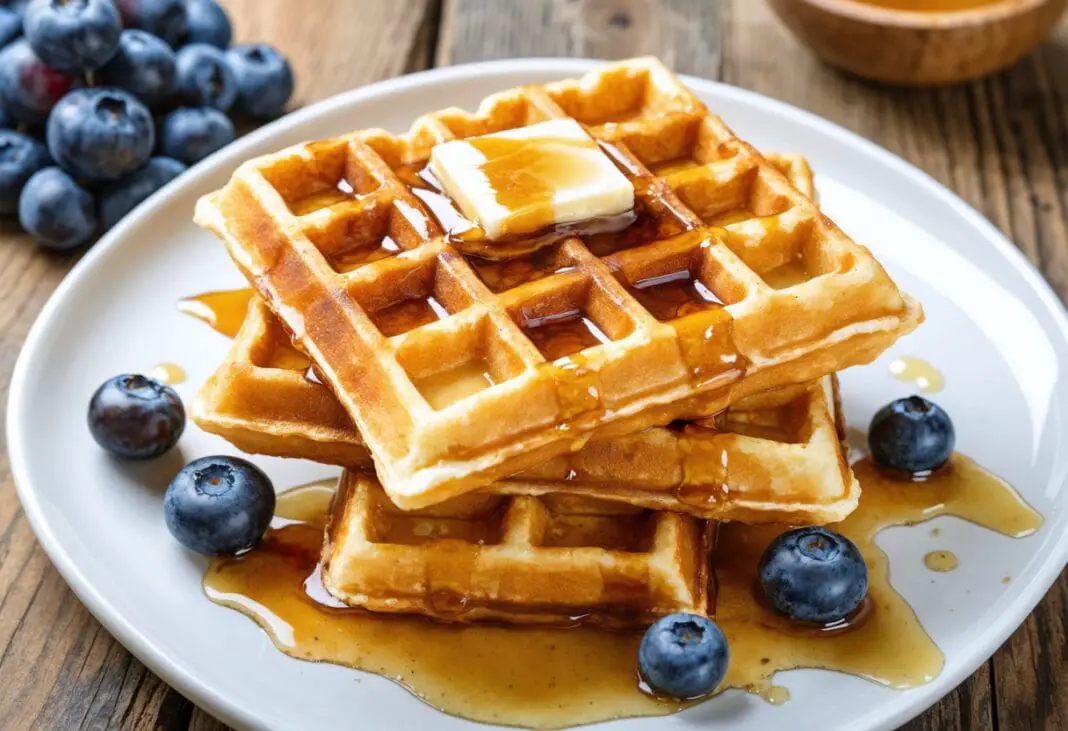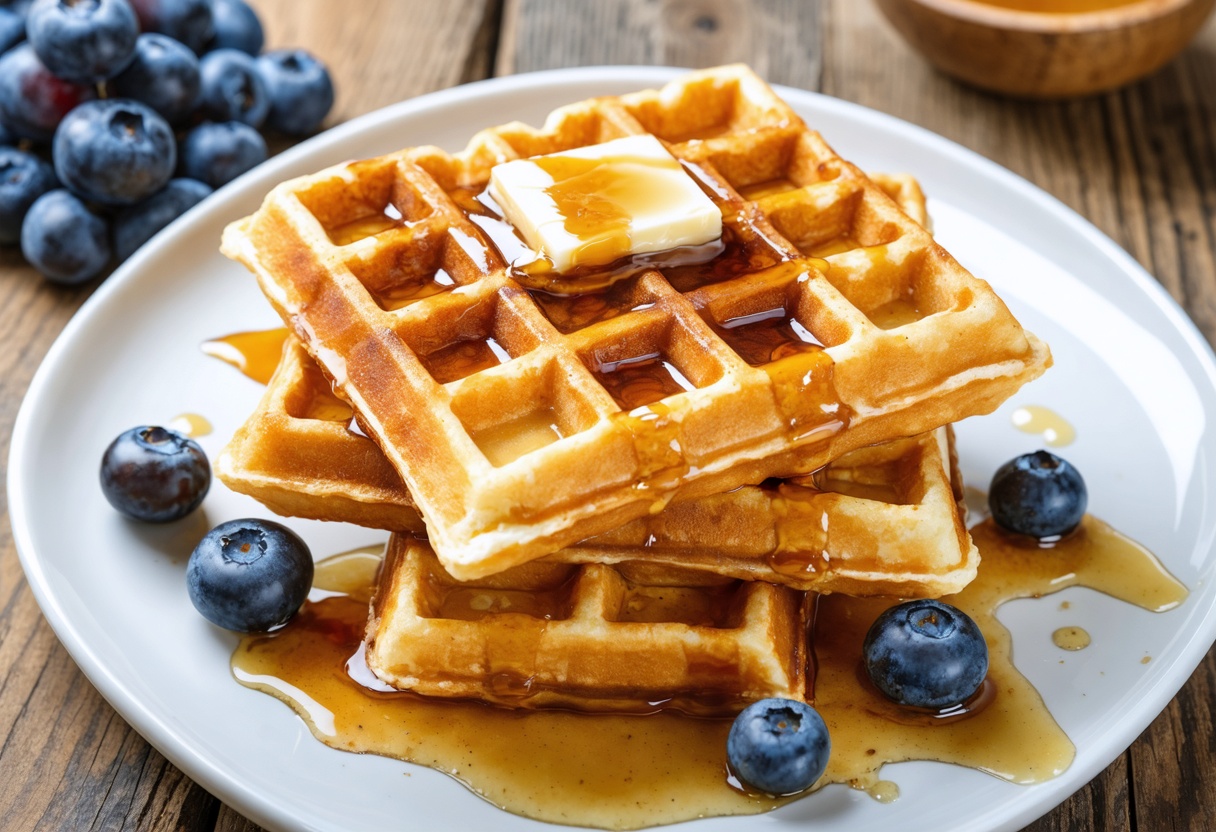Most people think making great waffles means using the fluffiest batter or the most expensive waffle maker. But there’s one simple ingredient sitting in most pantries that completely transforms ordinary waffles into crispy, golden perfection. This secret ingredient creates a satisfying crunch that regular flour simply can’t match, and once someone tries it, they never go back to plain waffles again.
Cornmeal creates the perfect crispy texture
The game-changing ingredient that transforms regular waffles into crispy masterpieces is cornmeal. Unlike regular flour, cornmeal adds a delightful crunch and heartiness that makes each bite more satisfying. When cornmeal hits the hot waffle iron, it creates tiny pockets of crispiness throughout the waffle, giving it texture that plain flour waffles simply can’t achieve.
This cornmeal addition works because the coarser grain structure holds up better to the high heat of the waffle iron. Regular flour can become dense and heavy, but cornmeal maintains its structure while adding a subtle corn sweetness. The result is waffles with crispy edges and a tender interior that stays light and airy.
Separating eggs makes all the difference
Most home cooks just crack whole eggs into their waffle batter, but separating the eggs and whipping the whites creates restaurant-quality waffles. The whipped egg whites trap air bubbles that expand when cooked, creating incredibly light and fluffy waffles with crispy exteriors. This technique works because the protein in egg whites forms a foam that holds structure throughout the cooking process.
Martha Stewart’s friend Donn’s recipe uses three egg whites for extra lift, which creates waffles with an almost popover-like texture. The key is beating the whites until stiff peaks form, then gently folding them into the batter to preserve those air bubbles. This method requires a bit more effort, but the difference in texture is immediately noticeable.
Buttermilk adds tang and better rise
Regular milk works fine for waffles, but buttermilk takes them to another level entirely. The acid in buttermilk reacts with baking soda to create extra lift, making waffles fluffier and lighter. Plus, buttermilk adds a subtle tangy taste that balances out the sweetness of syrup and other toppings perfectly.
Don’t have buttermilk on hand? Make homemade buttermilk by adding one tablespoon of lemon juice or white vinegar to one cup of regular milk, then let it sit for five minutes until it curdles. This simple substitution provides the same acidic reaction that creates better texture. The curdled appearance might look odd, but it works just as well as store-bought buttermilk.
Room temperature ingredients mix better
Cold ingredients from the refrigerator don’t blend well together, creating lumpy batter with uneven texture. Room temperature eggs, milk, and butter incorporate smoothly, resulting in a uniform batter that cooks evenly. Cold butter especially causes problems because it doesn’t mix properly, leaving chunks that affect the final texture.
Plan ahead by taking eggs and milk out of the refrigerator about 30 minutes before cooking. For butter, cut it into small pieces to warm it faster, or microwave it briefly if the recipe calls for melted butter. Warm milk prevents melted butter from solidifying when mixed together, which can create an unpleasant grainy texture in the finished waffles.
Oil beats butter for browning
Butter might taste great, but it doesn’t create the best waffle texture. Butter contains water, which interferes with proper browning and crispiness. Neutral oils like vegetable or canola oil have higher fat content without water, creating better browning and a crispier exterior that stays crunchy longer.
Research shows that waffles made with oil brown more evenly than those made with butter. The higher fat content in oil promotes better crust formation while keeping the interior tender. If the butter taste is important, add a pat of butter on top of the finished waffle instead of putting it in the batter itself.
Preheating the iron prevents sticking
Rushing to cook waffles on a barely warm iron creates disasters. The batter sticks, tears apart when removed, and cooks unevenly. A properly preheated waffle iron should be hot enough that water droplets sizzle and dance when sprinkled on the surface. This usually takes 5-10 minutes, longer than most people expect.
Even non-stick waffle irons need greasing before each batch. Use a pastry brush or paper towel to apply oil to all the grooves and surfaces where batter might stick. Cooking spray seems convenient but doesn’t reach into all the crevices where sticking typically occurs. Proper greasing ensures clean release and better texture.
Steam signals when waffles are done
Many people rely on timers or indicator lights, but steam provides the most reliable signal for perfectly cooked waffles. When the waffle iron stops producing steam, the waffles are usually done. If the lid resists opening slightly, give them another minute of cooking time to ensure they’re fully set and crispy.
Opening the iron too early creates soggy, undercooked waffles that fall apart. Wait for the steam to stop, then test the lid gently. Properly cooked waffles release easily and have golden-brown surfaces. Using consistent amounts of batter for each waffle helps maintain even cooking times throughout multiple batches.
Tossing removes excess moisture
Fresh waffles contain trapped steam that makes them soggy if not released quickly. Martha Stewart’s technique of gently tossing hot waffles between hands helps release this steam, keeping edges crispy longer. While this might seem unusual, it prevents the steam from condensing and making the waffle surfaces soft.
For those worried about burning their hands, placing waffles on a wire cooling rack achieves similar results. The air circulation around the waffle helps release moisture while maintaining crispiness. Avoid stacking waffles or covering them, which traps steam and creates soggy results even with perfect batter and cooking technique.
Gentle mixing prevents tough batter
Overmixing waffle batter develops too much gluten, creating tough, chewy waffles instead of light, crispy ones. Mix just until dry ingredients disappear, leaving a few lumps rather than achieving perfectly smooth batter. The lumps disappear during cooking, but overmixed gluten stays tough throughout the entire waffle.
Use a folding technique instead of vigorous stirring. Scrape batter from the bottom of the bowl and fold it over the top, rotating the bowl and repeating until combined. This gentle method preserves air bubbles while preventing gluten development. Hand mixing works better than electric mixers, which can overmix batter in seconds.
These simple changes transform basic waffle recipes into restaurant-quality breakfasts that friends and family will request repeatedly. The combination of cornmeal’s crunch, proper technique, and attention to temperature details creates waffles worthy of special occasions. Once these methods become routine, making exceptional waffles becomes as easy as making ordinary ones.
Crispy Cornmeal Waffles with Secret Ingredient
Cuisine: American4
servings20
minutes5
minutes320
kcalThese incredibly crispy waffles get their irresistible crunch from cornmeal and restaurant-quality texture from separated eggs.
Ingredients
1 cup all-purpose flour
1 cup yellow cornmeal
3 teaspoons baking powder
1 teaspoon salt
2 tablespoons granulated sugar
3 large eggs, separated
1 1/3 cups buttermilk
1/4 cup vegetable oil
Optional: mixed seeds (sesame, sunflower, pumpkin)
Directions
- Preheat waffle iron on highest setting for at least 10 minutes. In a large bowl, whisk together flour, cornmeal, baking powder, salt, and sugar until evenly combined. Make sure no lumps remain in the dry ingredients.
- Separate eggs carefully, placing whites in a clean bowl and yolks in another bowl. Beat egg whites with electric mixer until stiff peaks form, about 3-4 minutes. Set aside while preparing the rest of batter.
- Whisk egg yolks lightly, then add buttermilk and vegetable oil. Mix wet ingredients until smooth and well combined. Pour this mixture into the dry ingredients and fold gently just until combined, leaving some small lumps.
- Add half the beaten egg whites to batter and stir gently to lighten the mixture. Fold in remaining egg whites very carefully to preserve air bubbles, using a rubber spatula in a folding motion.
- Brush waffle iron thoroughly with oil, getting into all grooves and surfaces. Test heat by sprinkling water drops on surface – they should sizzle and dance. Pour appropriate amount of batter onto center of iron.
- If using seeds, sprinkle them lightly over batter before closing iron. Close waffle maker and cook without opening for about 4-5 minutes, until steam stops rising from the iron.
- When steam stops and lid lifts easily, remove waffle carefully. Immediately place on wire cooling rack or gently toss between hands for a few seconds to release steam and maintain crispiness.
- Serve immediately while crispy and hot. Repeat with remaining batter, re-oiling iron between batches. These waffles are best enjoyed fresh from the iron with butter, brown sugar, syrup, or fresh fruit.
Notes
- Egg whites must be beaten to stiff peaks for proper texture – under-beaten whites won’t provide enough lift
- Replacing buttermilk with regular milk plus 1 tablespoon lemon juice works as a substitute
- Don’t overmix the batter – a few lumps are better than tough, dense waffles
- Waffles are best served immediately as they lose crispiness quickly when cooled
- Leftover batter can be refrigerated for up to 2 days but may need gentle re-folding before use
Frequently asked questions
Q: Can I make the batter ahead of time?
A: The batter works best when used immediately after mixing. The beaten egg whites start to deflate over time, which reduces the fluffy texture. If needed, refrigerate for up to 2 hours and gently re-fold before cooking.
Q: What if I don’t have cornmeal?
A: Regular all-purpose flour can substitute for cornmeal, but the waffles won’t have the same crispy texture. For better results, try using fine-ground polenta or even crushed cornflakes as alternatives.
Q: Why are my waffles sticking to the iron?
A: This usually happens when the iron isn’t hot enough or properly greased. Make sure to preheat for at least 10 minutes and brush all surfaces with oil before each batch, even with non-stick irons.
Q: Can these waffles be frozen and reheated?
A: Yes, freeze cooled waffles in a single layer, then store in freezer bags. Reheat in a toaster or toaster oven to restore crispiness – avoid the microwave which makes them soggy.


